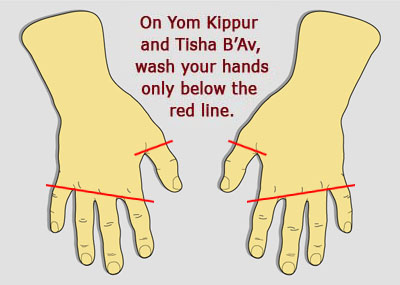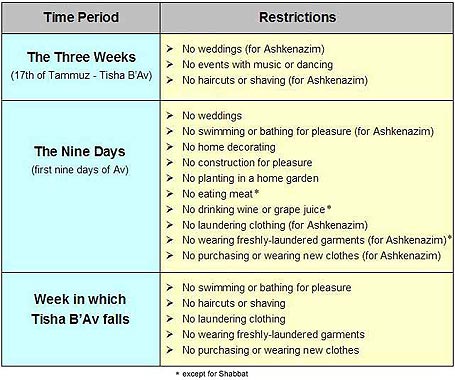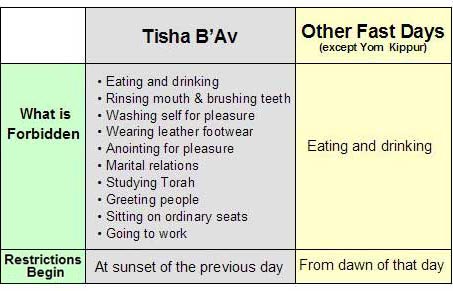 Raise a Glass to Freedom
Raise a Glass to Freedom


12 min read
Mourning the destruction of the Holy Temple.
Historically, the "Three Weeks" between the 17th of Tammuz and Tisha B'Av are days of misfortune for the Jewish people. During this time, both the First and Second Temples were destroyed, amongst other tragedies.

These days are referred to as the period "within the straits" (bein hametzarim), in accordance with the verse: "All her oppressors have overtaken her within the straits"
(Lamentations 1:3).
On Shabbat during the Three Weeks, the Haftorahs are taken from chapters in Isaiah and Jeremiah dealing with the Temple's destruction and the exile of the Jewish people.
During this time, we minimize joy and celebration. And since the attribute of Divine judgment is acutely felt, we avoid potentially dangerous or risky endeavors. Also, various aspects of mourning are observed by the entire nation. Read on for details...
The three-week period begins with the Seventeenth of Tammuz, a day on which five catastrophes occurred in Jewish history:
The Seventeenth of Tammuz is a fast day, where no eating or drinking is permitted from dawn until dusk. (Bathing, anointing, and wearing leather shoes are all permitted.) The purpose of the fast is to awaken our sense of loss over the destroyed Temple, and the subsequent Jewish journey into exile.
During the weeks leading up to Tisha B'Av (i.e. beginning from the Seventeenth of Tammuz), we gradually increase the intensity of our mourning. During this time there are a number of laws and customs:
The period commencing with Rosh Chodesh Av is called the "Nine Days." During this time, a stricter level of mourning is observed, in accordance with the Talmudic dictum: "When the month of Av begins, we reduce our joy."8 Restrictions include:
Home improvements, construction and decorating for pleasure purposes are forbidden.9 This includes building a vacation home, patio, etc. It is permitted to build a home or an extension that is needed for dwelling purposes. It is also permitted to build a synagogue10 or a mikveh.11
Planting trees or flowers in a home garden is forbidden.12
Eating meat or foods containing any meat (including poultry), as well as drinking wine or grape juice is forbidden during this time.13 But when the meal is for a mitzvah (i.e. a Shabbat meal, a bris milah meal or a siyum), it is permitted to eat meat and drink wine.15 Meat may also be eaten by one who needs to do so for health reasons, such as pregnant or nursing women who have particular difficulty with such dietary limitations.15
Washing clothes: According to Ashkenazi custom, one may not clean or launder clothes from the beginning of Av. (Sefardim begin this restriction from the Sunday of the week in which Tisha B'Av falls.)16 If a child frequently soils his clothes, they may be laundered.17
Clean clothes: Freshly laundered clothing may not be worn from the beginning of Av. (Sefardim begin this restriction from the Sunday of the week in which Tisha B'Av falls.)18 Young children may wear freshly laundered clothing.19 In any case, freshly laundered underclothes and socks may be worn by anyone.20 Further, it is permitted to wear any freshly laundered clothing for Shabbat.21
New clothes: In general, it is forbidden to purchase or make new clothes.22 It is permitted to repair torn clothing.23
Bathing and swimming for pleasure is forbidden.24 Bathing for medical purposes or to remove perspiration is permitted, but one should minimize the comfort by limiting the length and warmth of the shower/bath to whatever is necessary.25 On Friday, it is permitted to take a warm shower in honor of Shabbat.26 (According to the Sefardic tradition, this restriction begins in the week in which Tisha B'Av falls.)27
Litigation: One should avoid litigation with non-Jews, since fortune is inauspicious at this time.28 Activities that have an element of danger should be avoided during this time.29 Similarly, many people curtail pleasure trips during this time.30
Tisha B'Av ("the ninth day of the Hebrew month of Av") is the Jewish national day of mourning, which marks a series of calamities:
The Temple's destruction, and the subsequent dispersion of the Jews from Israel, left a scar on the Jewish people that has not healed. Indeed, other grave misfortunes throughout Jewish history occurred on Tisha B'Av, including:
On the afternoon prior to Tisha B'Av, it is customary to eat the Seudah Hamaf'seket – a meal consisting only of bread, water and hard-boiled egg. The food is dipped in ashes, symbolic of mourning.31 The meal should preferably be eaten alone, while seated on the ground in mourner's fashion.32
Tisha B'Av is the Jewish national day of mourning, marking the destruction of the first and second Temples. In order to instill an appreciation of this great loss, the laws of Tisha B'Av are generally stricter:
On other rabbinic fast days, it is forbidden to eat and drink from dawn until nightfall. On Tisha B'Av, however, the fast begins from sundown, and continues for approx. 25 hours until nightfall the next day.
Tisha B'Av has a number of additional restrictions, starting from sundown:
Rinsing out your mouth is forbidden, except in situations of great distress.33 If done, one must be careful to spit out and not swallow any of the water/toothpaste.
Washing for pleasure is prohibited.34 In the morning, one may wash netilat yadayim only until the knuckles.35 Even after using the restroom, one may wash the hands only until the knuckles.36 If one's hands (or other part of the body) became dirty, one may wash the unclean portion and nothing else.37 Washing for medical purposes is always permitted.38

Wearing leather footwear is forbidden on Tisha B'Av.39 Even if there is a bit of leather on any part of the shoe, it may not be worn.40
Applying substances to the body such as soap, ointment, perfume, cologne and the like are forbidden.41 This prohibition is only in effect when done for pleasure, but is permitted for any health reason.42 It is permitted to use a deodorant whose purpose is to remove or prevent a bad odor.43
Marital intimacy is forbidden.44 This includes any physical form of affection on the night of Tisha B'Av.45
Studying Torah is forbidden on Tisha B'Av, because it naturally gladdens the soul.46 However, one may study Torah sections that relate to the theme of the day (such as the Book of Job, portions of the Book of Jeremiah, the Talmudic and midrashic accounts of the Temples' destruction, the laws of Tisha B'Av, laws of mourning, etc.)47
Greeting people with terms such as "good morning," etc. is forbidden,48 as is offering gifts.49
Sitting on an ordinary seat is forbidden until halachic midday.50 It is always permitted to sit on the floor or on a low seat that is lower than 12 inches.51 After midday, one may sit on any seat.52 Additionally, we try to limit our comforts on the Tisha B'Av. For example, it is proper to sleep with less pillows than usual.53
Going to work, engaging in business or other distracting labors is generally prohibited before halachic midday, unless it will result in a substantial loss.54 For special circumstances, a rabbi should be consulted.
At the evening service, lights in the synagogue are dimmed, candles are lit, and the curtain is removed from the ark. The cantor leads the prayers in a low, mournful voice. The Book of Lamentations (Eicha), Jeremiah's poetic lament over the destruction of Jerusalem and the First Temple, is read.55 Although it portrays a gloomy picture of the state of the Jewish people, it ends on an uplifting note, reminding us that when we do teshuva, God will return us to our former glory.
At Shacharit, as an expression of mourning, one does not wear tallit or tefillin. Instead these are worn later in the day at Mincha.
At the end of Shacharit, we recite Kinot. This is a book of elegies over the loss of Jerusalem and other Jewish tragedies. The heartbreaking poetry was written by various authors than span a millennium. Kinot should not be read after halachic midday.56
On Tisha B'Av, we recite the special Aneinu prayer that is said on other fasts. Tachanun and Avinu Malkeinu are omitted.
Another insertion, called Nacheim, is added by Ashkenazim to the Amidah of Mincha,57 and by Sefardim to both Shacharit and Mincha. This is a moving plea to the Almighty to console those who mourn the Temple, and to rebuild Jerusalem.
Since the burning of the Temple continued through the 10th of Av, the following restrictions continue until midday of the 10th: haircuts, washing clothes, bathing, eating meat and wine, and listening to music.58
Following Tisha B'Av are the "Seven Weeks of Consolation" (Nachamu), where special Haftorahs are read on Shabbat.
The prophets teach us that in the End of Days, all of our fasts will turn into days of celebration, as the Messiah will herald a new era for the Jewish people.59 Through the process of teshuva – self-introspection and a commitment to improve – we have the power to transform tragedy into joy.
To the extent that we appreciate the loss of the Temple, is the extent that we hasten our redemption. For as the Talmud says: "He who mourns for the destruction of Jerusalem, will merit to see its rebuilding."60
Photo credit: Temple Institute – templeinstitute.org

If some of these guidelines seem unduly strict, we may need to more properly appreciate of the loss the Holy Temple – where the presence of God was most tangibly felt, where the Jewish people were united, and where Torah ideals spread to the world. In any case, if there are special circumstances, discuss them with a rabbi, as there may be room for leniency.

